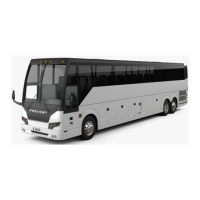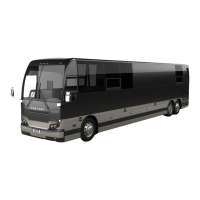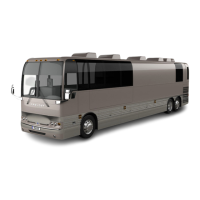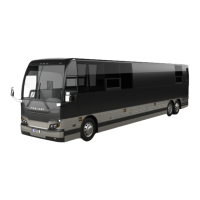Do you have a question about the PREVOST X3-45 Commuter 2020 and is the answer not in the manual?
General information about the manual and vehicle features.
Details on maintaining emission control devices and systems.
Information on event data recorders and telematics devices.
Details on the vehicle's Event Data Recorder (EDR).
Information regarding the vehicle's Telematics Device and services.
Procedures for updating ownership or contact information.
How to address questions or complaints with Prevost.
Procedures for reporting safety defects to authorities.
NHTSA contact information for reporting safety defects.
Transport Canada contact information for reporting safety defects.
Guidelines for safe vehicle operation and maintenance.
Techniques for safe driving in various conditions.
Additional safety precautions, including warnings and cautions.
Overview of the coach's exterior components.
Identification and location of rooftop antennas.
Information on the function and operation of cornering lights.
Identification of various components within the engine compartment.
Procedure for opening the engine compartment's rear door.
Procedure for accessing the exhaust aftertreatment system.
Procedure for opening the engine compartment's curbside door.
Description of the main power compartment and its contents.
Procedure for accessing the engine radiator door.
Location and access to the SCR converter hatch.
Details about the A/C condenser compartment.
Information on the HVAC evaporator compartment.
Location and procedure for accessing the fuel and DEF filler door.
Information about the rear fenders and their access.
Location of the air dryer and related components.
Details on baggage compartments, capacity, and locking.
Procedure for opening wheelchair lift access doors.
Access and contents of the front electrical and service compartment.
Operation and locking of the bi-part entrance door.
How to operate the entrance door from the exterior.
Explanation of the door operation control logic.
Procedure for emergency opening of doors.
Description and adjustment of rear-view mirrors.
Functionality and usage of the back-up camera system.
Location and purpose of the hubodometer.
Description and location of interior mirrors.
How to adjust HVAC registers for air flow.
Features and adjustment of the Recaro driver's seat.
Proper usage and safety of the driver's seat belt.
Description of passenger seating arrangement and features.
Information on the integrated USB power outlets.
How to reconfigure seats for mobility devices.
Guidelines for passenger seat belt usage.
Features and amenities of the overhead console.
How to adjust air registers for passenger comfort.
How passengers can request a stop.
Operation and features of reading lights.
Functionality of the automatic passenger counter system.
General description of coach windows.
Details on panoramic windows and their types.
Operation of the driver's power window.
Use of sunshades in the driver's area.
Operation of windshield sunshades.
Location and operation of ventilation hatches.
Details on the digital information screens.
Storage and access for overhead compartments.
Components located in the first overhead compartment.
Description of the driver key and square drive T-key.
Usage of the driver key for various locks.
Usage of the square drive T-key for compartment access.
Operation of the ignition switch and start button.
Layout and components of the driver's area.
Controls and switches on the lateral control panel.
Operation of the Allison transmission control pad.
How to open/close the entrance door using the switch.
General information on the vehicle's control switches.
Adjustment and operation of the mirror controls.
Operation of the parking brake control valve.
Emergency relief valve for the entrance door.
Function of the silent alarm button.
Overrule system for emergency/parking brakes.
Function of the mobile view tag event button.
Location and use of the OBD receptacle.
Overview of the AFSS system.
How to manually activate the AFSS system.
Information displayed on the AFSS panel.
Overview of the dashboard layout and controls.
Detailed descriptions of various control switches.
Operation of the passenger area HVAC unit.
Controls for the driver's HVAC system.
Adjustment of air registers for driver comfort.
Components and displays on the instrument panel.
Levels of information provided by the instrument cluster.
Explanation of analog gauges on the instrument panel.
Meaning and function of various telltale lights.
Interpretation of STOP, CHECK, and INFO telltale lights.
Function and display of the Driver Information Display (DID).
Pictograms and their meanings on the DID.
Operation of the vehicle's horn.
How to adjust the steering wheel.
Description of foot-operated controls.
Operation of the headlight beam toggle switch.
Operation of the left turn signal switch.
Components and function of the exhaust aftertreatment system.
Role of the filtration and regeneration unit in soot management.
How passive regeneration of the DPF occurs.
Process of active regeneration for the DPF.
Procedure for stationary regeneration of the DPF.
Telltale light sequences for DEF clogging.
Function and components of the SCR unit.
Driver warnings and system inducements for SCR.
Navigation and options within the DID menus.
Display and function of various gauges in the DID.
Information on fuel consumption and data.
Settings and displays related to time, distance, and trips.
How to access and interpret vehicle active messages.
Procedure for resetting trip data.
Options for customizing display settings like language and units.
Accessing and using the vehicle diagnostics menu.
Features to aid in pre-trip vehicle inspections.
Accessing and understanding the data log.
Options for managing the aftertreatment system, like regeneration.
Information about password-protected functions.
Display of brake lining wear status.
System for communication between driver and fleet operator.
Battery saving sleep mode for the vehicle.
Operation and benefits of the transmission retarder.
Integrated safety systems for braking and stability.
Function and operation of the ABS system.
Function and operation of the ESC system.
How the kneeling system lowers the coach.
Description of the rear gauge in the engine compartment.
How the gauges behave during start-up.
The active state of the ignition system.
Accessing and performing self-diagnostics.
Automatic unloading of the tag axle.
How the driver is notified about tag axle status.
Function of traction control, especially with tag axle.
Manual override for the automatic tag axle unloading.
Operation and safety of the wheelchair lift system.
Operation of the ignition switch and start button.
Procedures for starting the engine.
How to start the engine from the driver's seat.
How to start the engine from the engine compartment.
Precautions and procedures for starting in cold weather.
Safe procedures for jump-starting the vehicle's battery.
System features that protect the engine from critical conditions.
How the engine automatically shuts down to prevent damage.
Timer that shuts down the engine after prolonged idling.
Proper procedure for warming up the engine after starting.
Procedures for warming up the Allison transmission in cold weather.
Steps to restart the vehicle after a fire alarm.
Location and operation of emergency exits.
How to use side windows as emergency exits.
How to operate roof hatches as emergency exits.
Procedure for opening the entrance door in an emergency.
List and description of onboard safety equipment.
Location and usage instructions for the fire extinguisher.
Use of warning reflectors for roadside breakdowns.
Operation and components of the automatic fire suppression system.
Location and use of emergency air fill valves.
Functionality of emergency and parking brake systems.
How to use indicators to check for loose wheel nuts.
Information on towing and jacking points.
Function and operation of daytime running lights.
Operation of the pedestrian turn warning system.
Function of the back-up alarm.
Essential functions available in limp-home mode.
List of available functions in limp-home mode.
Overview of the vehicle's camera system and locations.
Function of the driver monitor display.
Operation and safety of the back-up camera.
Recommended cleaning procedures for various vehicle surfaces.
Cleaning and stain removal tips for seat upholstery.
Cleaning instructions for plastic and vinyl surfaces.
How to clean the vehicle's windows.
Cleaning procedures for stainless steel components.
Stain removal from high-pressure laminate surfaces.
Recommended carpet maintenance.
Cleaning guidelines for rubber components.
Procedures for cleaning the vehicle's floor.
Recommendations for cleaning and maintaining exterior surfaces.
Cleaning and maintenance of the windshield.
Importance and procedures for checking fluid levels.
How to check and maintain the engine oil level.
How to check and maintain the transmission fluid level.
How to check and maintain the power steering fluid level.
How to check and maintain the engine coolant level.
Checking the windshield washer fluid level.
Other routine inspections for vehicle components.
Inspection and maintenance of electric cooling fans.
Procedure for purging air tanks.
Inspection and maintenance of the fire extinguisher.
Maintenance and draining of the fuel filter.
Inspection and maintenance of A/C compressor belts.
Inspection and maintenance of alternator drive belts.
Cleaning and maintenance of the back-up camera.
Checking and understanding the engine air filter restriction indicator.
Inspection and cleaning of A/C and heating system air filters.
Procedures for inspecting hoses for leaks and damage.
General lubrication guidelines for the vehicle.
Checks for wheels and tires, including nuts and pressure.
Checking wheel bearings for overheating.
Procedure for testing the service brake system.
Procedure for testing the parking brake system.
Using test mode to verify exterior lighting functionality.
General advice for vehicle operation and maintenance.
Daily inspection checklist for the vehicle.
Initial checks when approaching the vehicle.
Preparation steps before starting the engine or driving.
Physical dimensions and weight ratings of the vehicle.
Fluid capacities for various vehicle systems.
Vehicle turning radius specifications.
Recommended fuel type and its importance.
Guidelines and limitations for using biodiesel fuel.
Specifications for wheels and tires.
Recommended tire inflation pressures.
Belt applications, types, and quantities.
Technical specifications of the Volvo D13 engine.
Specifications for the Allison transmission.
Gear ratios for the Allison transmission.
Specifications for the propeller shaft.
Description of the vehicle's braking system.
Effective area of brake chambers for each axle.
Details about the vehicle's air system components.
Technical details of the ABS system.
Functionality of the traction control system.
Specifications of the steering system.
Electrical system specifications, including voltage and alternators.
Details of the vehicle's suspension system.
Components of the front I-beam axle suspension.
Components of the drive axle.
Components of the tag axle.
Static wheel alignment specifications for the axles.
| Transmission | Allison B500 |
|---|---|
| Category | Buses |
| Manufacturer | Prevost |
| Model | X3-45 Commuter |
| Year | 2020 |
| GVWR | 54, 000 lbs |
| Air Conditioning | Yes |
| Wheelchair Accessible | Yes |
| Engine | Detroit Diesel DD13 |
| Length | 45 ft |
| Width | 102 in |
| Horsepower | 450 hp |











